Text by Sarah Wetzlmayr
There were times when luxury yachts were primarily noted for their opulence and design overload. Today, that’s different—reduction and clarity define modern yacht design. Leading manufacturers like Wally, Riva, or Heesen are increasingly striving to make highly complex systems disappear behind calm surfaces and clean lines, with the goal of creating visual silence.
»Sprezzatura«—from the depths of the seemingly endless sea of words, Felix Kilbertus, Chief Creative Officer at Pininfarina, unearths an almost forgotten Italian term that perfectly summarizes what matters in the design of modern luxury yachts. »The idea of a kind of effortless grace, often described as the art of making something difficult look easy, or maintaining a nonchalant demeanour while performing complex tasks,« explains the designer in conversation with Chapter—adding: »This for me is the essence of luxury boating, something to be experienced as effortless simplicity, while very hard to obtain in reality, necessitating countless systems in the background constantly engaged to create this sensation of freedom and simplicity.«

wallywind110: “The clean deck layout is born from safety and practicality, ideas that have been part of Wally’s DNA since the very beginning,” explain the responsible designers of the renowned design studio Santa Maria Magnolfi.
Packaging highly complex technology in a way that conveys precisely this blend of effortlessness and elegance is one of the biggest challenges in luxury yacht design. At the same time, this is precisely what makes it so appealing, as designers repeatedly confirm. »Today, this means integrated technology, invisibly deployed, providing function without friction. Smart technology that disappears into the user experience, from cybersecurity to intuitive control systems using voice, gesture, or AI-assisted automation. Most relevantly, however, clients demand seamless connectivity for hybrid work, entertainment, and immersive audio-visual systems, integrated lighting design, and responsive climate control,« Felix Kilbertus continues his explanations. The native Austrian has been CCO of the Italian design firm since 2023; prior to that, he was Head of Exterior Design at the British luxury car brand Rolls-Royce. Since the 1960s, Pininfarina has also been involved in yacht design, most recently developing the interior of Wally’s highly acclaimed sailing yacht Wallycento Tango.
REDUCTION
TO THE
ESSENTIAL
When it comes to radical reduction, one cannot avoid talking about the Wally shipyard, launched by Luca Bassani in 1994. »The industry has absorbed many lessons from the radical reductionism pioneered by Wally and designer Luca Brenta at the turn of the century. This rupture with traditional nautical recipes and bringing in a sense of deep beauty has raised the bar considerably for the entire industry,« Felix Kilbertus is also convinced. Valentina Magnolfi and Federico Santa Maria, the duo behind the renowned design studio Santa Maria Magnolfi, work closely with Wally. In their view, however, reduction is not the right term for their work, but rather »rigor«, a certain formal strictness, as Magnolfi and Santa Maria explain. This strictness, however, is not in contradiction with luxury, comfort, and safety, they add. »Our work is based on a concept of essentiality, one that begins with the idea of being aesthetically coherent and respectful of the environment in which the object is meant to exist: the sea.«
The decision to hide complex technical components not only has aesthetic reasons but is also safety-relevant, as the Milan-based design duo explains in an interview with Chapter. »The clean deck layout is born from safety and practicality, ideas that have been part of Wally’s DNA since the very beginning. On the wallywind110, for instance, elements such as mooring areas, air outtakes, control panels and chartplotter screens are all integrated within the bulwarks. When not in use, nothing is visible, preserving the purity of the lines.«
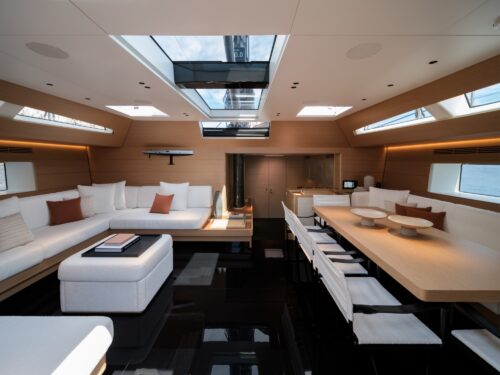
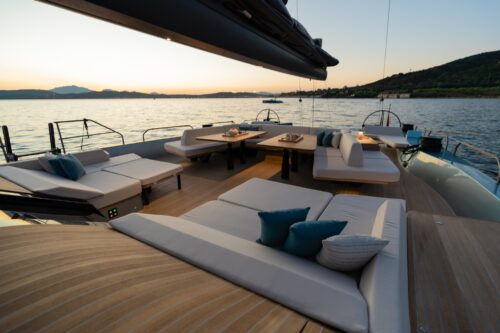
Wally is known for luxury yachts with outstanding design, technology, and performance. The wallywind110 sailing yacht, with its wide decks, also offers spacious, elegant entertainment and relaxation areas—complemented by a light-filled interior concept with clear design language.
The goal should never simply be to hide technology, explains the design team of the Dutch shipyard Heesen. Rather, it’s about creating clear lines and integrating technology as seamlessly as possible. If a technological detail fits into the overall aesthetic of the yacht, it can certainly be visible. »The core principle is that complexity should serve simplicity, creating an environment of effortless elegance for the owner.« The design team working for the traditional Italian shipyard Riva also emphasizes the »purity of lines« as a stated goal. According to them, the fact that a clear, uncluttered design contributes greatly to safety on board the yacht should also not go unmentioned: »In a nutshell: Cleanliness facilitates this ease of use.« The desire to achieve the greatest possible harmony through reduction does not, however, exclude the possibility that technological features can sometimes be deliberately brought into focus. »Just think of the control panels that nowadays are increasingly integrated and equipped with touch screen displays. They are often very attractive to look at—even on small boats—and becoming part of the on-board experience.« The deliberate hiding of technology, on the other hand, occurs, for example, with technical elements that are necessary for safety and navigation and therefore cannot be eliminated, but which, if openly exposed, can impair the elegance of a yacht’s profile. As an example, the Riva design team mentions cranes for yacht tenders, i.e., for those small dinghies with which larger yachts are often equipped. »They are often hidden from view in specially designed niches.«
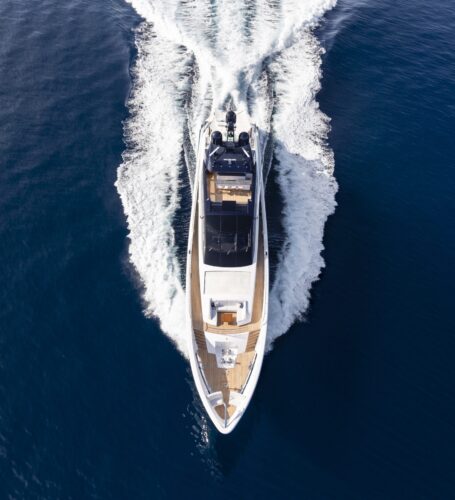
An example of modern luxury architecture on the water:
The Heesen Irisha—a 51-meter smart-custom motor yacht, designed by the British design studio Harrison Eidsgaard.
At Heesen, a Dutch brand for custom-built superyachts, reduction is also central—but not in the sense of design sterility. When asked whether the desire for clarity and reduction doesn’t also carry the risk of creating a feeling of coldness, the Heesen design team quickly dismisses the idea. They are convinced that the opposite is true. »A minimalist approach isn’t about creating a cold or empty space, but about setting a stage. It allows the owner’s personality, art collection, and way of life to become the central focus. The emotion comes from the quality of the light, the texture of the materials, the connection to the sea, and the freedom the space provides—not from excessive decoration.«
Felix Kilbertus shares this view and additionally raises the question of what is essential: »I believe that the most memorable things are essential, often deceivingly simple. Just think of portrait photography—you want to capture the essence of a person, but in all its complexity. It’s like a melody, where too many notes can distract, especially when the hierarchy between the main theme and supporting texture isn’t clearly expressed.«
ELEGANCE
INSTEAD OF
OPULENCE
For the Heesen design team, the roots of this clearly recognizable need for clarity and reduction clearly lie in the longing for tranquility in a world characterized by constant accessibility and overstimulation. »The yacht is a sanctuary. Purity and freedom in design—clean lines, open spaces—foster a profound sense of relaxation. Our clients seek to spend time on their yacht to escape the noise of the world, and a minimalist, considered design is the foundation for that serene experience.«
Felix Kilbertus agrees—modern yachts are no longer floating palaces, but rather retreats where the possibility of genuine connection—with family, friends, and nature—is inherent. All in the spirit of: »Reduction is the tool to get to what truly matters.«
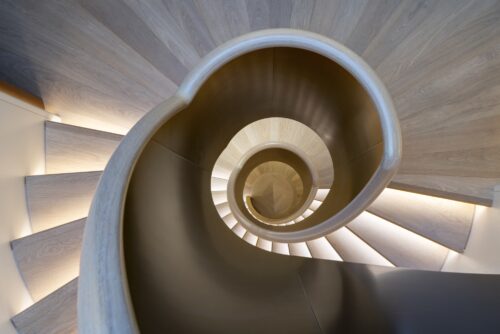
Heesen’s Ultra G Luxury Motor Yacht: The interior was designed by the British studio Harrison Eidsgaard.
A highlight is the spiral staircase connecting all four decks.
Not just going with the flow, but confidently making waves, albeit a bit more quietly than before, could be the credo of modern yacht design. The French architect and designer Philippe Starck also seems to have dedicated himself to this or a similar approach in the design of his superyachts. Luca Bassani described the 119-meter-long Motor Yacht A, designed by Starck, as »uncompromised« in an interview. »Everything is hidden, everything is closed. You don’t see any of the menial details and that makes a big difference«. For the same client, Russian entrepreneur and billionaire Andrei Melnichenko, Starck also designed the 143-meter-long Sailing Yacht A. He also designed the motor yacht Venus for Steve Jobs, which was completed only a year after Jobs’ death in October 2011 and was characterized, among other things, by his unconditional desire for tranquility. »We always wanted less and less, which was fabulous,« Starck summed up the collaborative design process with the Apple visionary in an interview.
A statement that fits with Philippe Starck once calling himself »the king of concentration.« Although he was referring to the mental state of absolute focus at the time, there is also something else resonating—namely Starck’s ability to extract and emphasize the essence of an object. Philippe Starck also describes his approach to luxury yacht design as a conscious break with the cliché of monetary excess. Instead, he is concerned with the elegance of intelligence and joie de vivre. In his work, he first focuses on harmony with the sea, then on the principle of an almost religious reduction —to the minimum of what is visible—as well as on technological innovations that elude the eye.
NEW
LUXURY
One thing is certain: when the concept of luxury is discussed today, it is no longer about pure opulence. »We are seeing a deep shift from traditional opulence to a more nuanced, experience- led, and purposedriven interpretation of value across luxury sectors,« Felix Kilbertus summarizes his view and adds: »I believe contemporary luxury falls in three categories: Materiality-based, experiential and self-actualization. While the archaic codes of luxury are powerful forces to be reckoned with—provenance, precious materials, symbols of status, power and dominance—we have developed a more sophisticated understanding of what luxury means today. I see materiality-based luxury evolving into a celebration of craftsmanship, tactility, and authenticity—where the choice of materials communicates values rather than price. Experiential luxury shifts the focus from possession to presence: the ability to disconnect, feel safe, and be immersed in beauty and nature. And at its most evolved, luxury becomes a form of self-actualization—designing spaces, objects, and moments that reflect who we are, how we think, and what we stand for. These three approaches define a more meaningful, human-centred expression of luxury—one that resonates deeply across disciplines, from yachts to mobility to architecture.«
For several years now, the choice of materials has also coincided with a growing demand for sustainability from many manufacturers of luxury products. This also applies to the development of luxury yachts, Kilbertus emphasizes. »In many ultra-high-networth circles, sustainability is now equated with discernment and cultural leadership. Clients want their yachts to reflect ecological intelligence without compromising elegance or performance.«
Heesen also believes that sustainability must now be an integral part of the design and development of luxury yachts. More efficient hull designs and hybrid propulsion systems are part of this, as is the reduction of the ecological footprint within the company and of the yachts themselves.
WHO WILL
DARE FIRST?
Where is the journey heading now? Will reduction remain the guiding design principle in the future, or are other trends emerging? At the end of our conversation, the Heesen design team takes the opportunity to delve into a small trend forecast: »We are observing a few key trends. Firstly, an even stronger connection to the water, achieved through expansive use of glass, innovative beach club designs, and folding terraces. Secondly, a heightened focus on wellness, with requests for dedicated gyms, spas, and spaces for relaxation becoming standard. Finally, the seamless integration of smart technology to enhance user experience is critical, as is the continued drive towards more sustainable and efficient yachts that can explore the world with a lighter touch.«
The design team of the Italian Riva yachts also recognizes the tendency to create the greatest possible connection to the sea through the use of glass surfaces. »It allows both in the hull and in the superstructures to achieve bright interiors and to reduce the barriers between inside and outside«. Not a thing of the future, but a feature already frequently used, are fold-out balconies or terraces attached to the sides, which contribute to increasing the usable area. »This is a trend first experienced on very large yachts and that is now being implemented also on boats of smaller dimensions.«
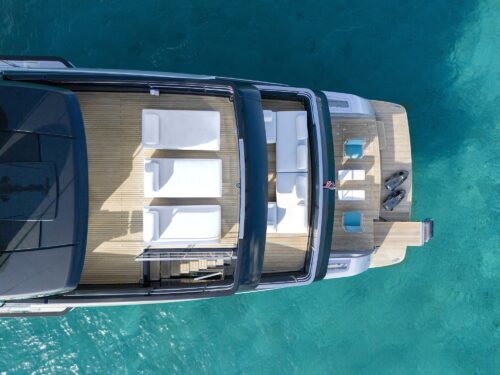
Riva 130′ Bellissima: With a length of almost 40 meters, three continuous decks, and a clear, elegant design language, this luxury yacht marks a new milestone in Riva’s portfolio.
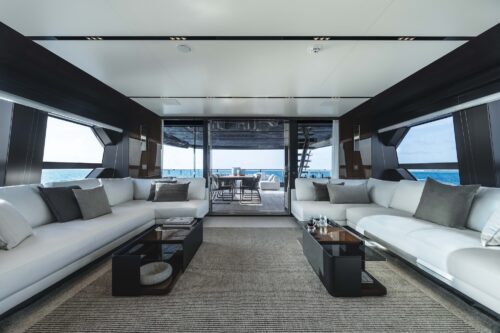
Large glazed areas on the main and upper decks create bright, open living spaces—and enable the
greatest possible connection to the sea.
»A design that blends in with the sea rather than shouting over it,« summarizes Pininfarina CCO Felix Kilbertus. He also states that there are some promising ideas, which are based, among other things, on innovations in architecture. »But then again—and very broadly speaking—we are not seeing a specific disruptive design trend, at least not quite yet,« says the designer’s conclusion. »However, the current winds of change might encourage some actors—the shipbuilders, naval architects, designers but also the owners—to really go beyond the currently imaginable. With all the incredible development tools at our disposition, there are very few actual limitations today to what can be achieved. Who will dare first?«
Perhaps an important step on this path could be to unearth the term »Sprezzatura« from the depths of the seabed. To be able to name the feeling that arises when a modern luxury yacht no longer screams for attention, but its visual silence allows one to listen to the sound of the sea. Or, to put it in Philippe Starck’s words: »We always wanted less and less, which was fabulous.«
ARTICLE FIRST PUBLISHED IN CHAPTER №XII »SIMPLICITY« — SUMMER 2025

